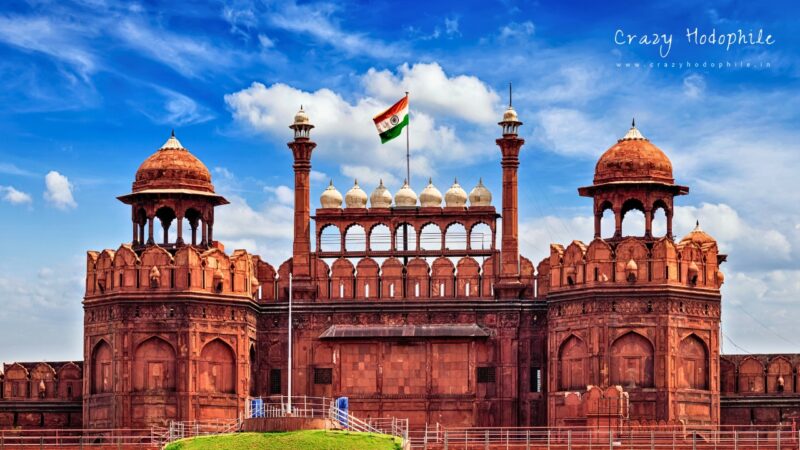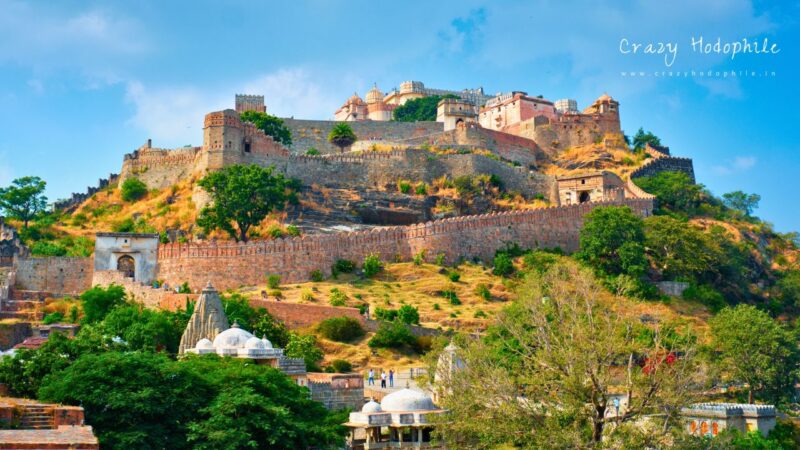Hawa Mahal Jaipur: Architecture, History, and Cultural Significance | Crazy Hodophile | 2025
Hawa Mahal, also known as the “Palace of Winds,” is an iconic monument located in Jaipur, Rajasthan, India. It is a five-story structure made of red and pink sandstone. The palace is renowned for its unique architectural design, which features 953 small windows, or “jharokhas” that resemble a honeycomb.
Table of Contents
Overview
This unique architectural marvel was designed to allow the royal women to observe street festivals and everyday life from behind the screens without being seen, following the purdah system of the time. The structure is pyramid-shaped and stands at 50 feet (15 m) high. The use of red and pink sandstone reflects the signature style of Jaipur’s architecture. It stands as a prime example of Rajput architecture with intricate latticework and decorated front walls, symbolizing the blend of beauty and functionality.

Architectural Style
- Pyramid Shape: It is designed in the form of a pyramid, with five tiers that gradually decrease in height. The facade resembles a honeycomb, with 953 small windows adorned with delicate latticework.
- Latticework (Jaalis): The jaalis allow air to pass through, creating a Venturi effect that keeps the interiors cool during the hot summer months. This also allowed the royal women to observe the street life and festivals without being seen, adhering to the purdah system.
Major Attractions
- Panoramic Views: The top floors provide stunning views of Jaipur, including landmarks like the City Palace and Jantar Mantar.
- Museum: The Hawa Mahal Museum, located inside the palace, houses a collection of artifacts, including weaponry, costumes, and paintings from the royal era.
- Fountain: Enjoy the serene fountain located within the palace grounds, providing a refreshing ambiance and a picturesque spot for visitors to relax and take in the beauty of the surroundings.
- Jharokhas (Windows): The palace’s 953 small windows, or jharokhas, are a unique feature that allows air to circulate, keeping the palace cool. They also provide excellent views of the city.
Opening and Closing Time
Hawa Mahal welcomes visitors every day of the week from 9:00 AM to 4:30 PM.
Best Time to Visit
The best time to visit Hawa Mahal is during the cooler months, from October to February. The weather is pleasant, making it easier to explore the palace and other attractions in Jaipur. Early morning visits are particularly recommended for a serene experience and beautiful photography.
If you visit Hawa Mahal during the summer months (March to July), keep these tips in mind:
What to Do:
- Visit Early: Arrive as early as possible to avoid the midday heat.
- Stay Hydrated: Carry plenty of water to stay hydrated.
- Wear Light Clothing: Dress in light, breathable fabrics to stay cool.
What to Avoid:
- Avoid Midday Visits: Try not to visit during the peak heat hours, usually from noon to 3 PM.
- Heavy Meals: Avoid heavy meals before visiting to prevent discomfort in the heat.
Entrance Fee
- Indian Visitors: ₹50 per person
- Foreign Visitors: ₹200 per person
Note: Please note that entrance fees are subject to change.
Suggestion: For a more enriching experience, consider hiring a local guide or using the audio guides available at the entrance. However, be aware that some guides have been known to overcharge visitors, so be sure to negotiate the fee before hiring one. Also, it’s advisable to carry cash for purchases, as some places may not accept online payments.
History
Hawa Mahal stands as a testament to the visionary Maharaja Sawai Pratap Singh, who, in the late 18th century, drew inspiration from the enchanting Khetri Mahal to create this architectural marvel. Built-in 1799, this grand palace was designed by Lal Chand Ustad in the form of the crown of Shri Krishna.
Maharaja Sawai Pratap Singh, captivated by the intricate design and cooling effect of the wind palace, envisioned a structure that would allow the royal ladies to observe street processions and festivals while maintaining their privacy. The result was the iconic facade of Hawa Mahal, adorned with 953 intricately carved windows (jharokhas), intricately designed to catch the breeze and keep the palace cool even during Rajasthan’s scorching summers.
Material Use
- Red and Pink Sandstone: The primary materials used in the construction of Hawa Mahal are red and pink sandstone, which are abundant in Rajasthan. The red sandstone gives the structure its distinctive hue, while the pink sandstone adds to its visual appeal.
- Marble and Lime Mortar: The interiors of Hawa Mahal are made using marble and lime mortar. Marble, with its cooling properties, is used extensively in the floors and some decorative elements. Lime mortar provides strength and longevity to the structure, ensuring it stands the test of time.
- Stucco Decoration: The intricate stucco work on the exterior walls adds to the palace’s ornate appearance. The stucco is applied over the sandstone and intricately carved into floral and geometric patterns, showcasing the artisans’ skills.
2006 Renovation and Restoration Work
In 2006, after a hiatus (gap) of 50 years, extensive renovation and restoration work began on the Hawa Mahal, costing an estimated Rs 4.568 million. This initiative aimed to rejuvenate the monument, preserving its historical integrity, ensuring structural stability, and enriching the visitor experience.
The restoration efforts included meticulous cleaning of the intricate latticework (jaali) and the vibrant pink sandstone facade, returning them to their original splendor. Installation of ramps, elevators, and improved pathways to enhance accessibility for visitors, including those with disabilities. Upgrading visitor amenities such as information centers, guided tour services, and restroom facilities to improve the overall visitor experience. This undertaking underscores ongoing efforts to safeguard Jaipur’s architectural heritage, ensuring that this iconic monument remains a captivating attraction for visitors worldwide.
How to Reach
- By Air: Jaipur International Airport is the nearest airport to Hawa Mahal, located approximately 12 km away. A taxi ride from the airport usually lasts around 25 to 30 minutes, varying according to traffic conditions.
- By Train: Jaipur Railway Station, situated around 5 km from Hawa Mahal, is the closest railway station. You can reach Hawa Mahal from the railway station in about 15 minutes by auto-rickshaw or taxi.
- By Bus: Sindhi Camp Bus Station serves as Jaipur’s main bus terminal and is located approximately 3.7 km from Hawa Mahal. From Sindhi Camp, you can easily find auto-rickshaws, taxis, or cycle rickshaws to reach Hawa Mahal.
- By Own Vehicle or Taxi: Jaipur is well-connected by highways, making it easily accessible by private vehicle or taxi.
Location Map for Hawa Mahal
Exciting Activities
Near Hawa Mahal in Jaipur, there are several activities and attractions to explore, offering a rich blend of history, culture, and vibrant experiences:
- Photograph the Facade: The iconic honeycomb facade of Hawa Mahal is a photographer’s delight. Capture the intricate designs and vibrant colors of this architectural marvel.
- Attend Light and Sound Show: Experience the light and sound show at Amber Fort, which narrates the history of Jaipur and its rulers, offering a captivating evening activity.
- Shopping: Explore the vibrant bazaars of Jaipur, like Johari Bazaar, Tibbati Bazaar, and Bapu Bazaar.
- Attend Cultural Performances: Many venues near Hawa Mahal host cultural performances such as folk dances, puppet shows, and traditional music, offering insights into Rajasthan’s vibrant arts scene.
- Enjoy Local Cuisine: Indulge in Rajasthani cuisine at nearby restaurants and cafes, sampling delicacies like dal bati churma, gatte ki sabzi, and traditional sweets like ghewar.
What’s Worth Seeing Near Hawa Mahal
- City Palace: Located around 650 meters from Hawa Mahal, this royal residence includes museums and courtyards that showcase the opulence and history of Jaipur’s royal family.
- Govind Dev Ji Temple: Situated about 700 meters from Hawa Mahal, this renowned Hindu shrine dedicated to Lord Krishna is within the City Palace complex. The temple is famous for its multiple aartis (worship rituals) and jhankis (tableau displays) performed throughout the day, offering visitors a vibrant and spiritually enriching experience.
- Jantar Mantar: Approximately 750 meters away, Jantar Mantar is a UNESCO World Heritage site and an astronomical observatory housing nineteen architectural astronomical instruments. It is just a short walk from Hawa Mahal.
- Albert Hall Museum: Located around 2.3 kilometers from Hawa Mahal, this museum in Ram Niwas Garden showcases a rich collection of artifacts including ancient coins, sculptures, and traditional Rajasthani attire.
- Jaipur Zoo: About 2.4 kilometers from Hawa Mahal and next to Albert Hall Museum, Jaipur Zoo is home to a variety of animal and bird species.
- Raj Mandir Cinema: Approximately 3.4 kilometers from Hawa Mahal, this iconic movie theater is known for its opulent interiors and grandiose design, offering a unique cinematic experience.



